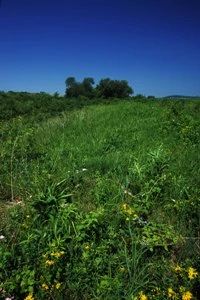Belmont Prairie
No. 364

Photo by Thomas A. Meyer/DNR
Located along the Pecatonica State Trail, Belmont Prairie is a small mesic to dry prairie remnant with over 80 species of native plants. This stretch of prairie lies within a former railroad right-of-way, which is one reason for the prairie's preservation. While most mesic prairies have been nearly extirpated from the state due to human settlement and agriculture, Belmont Prairie was preserved, in part, by the unintentional fires sparked by the rails and stray cinders from passing locomotives.
The fires encouraged the growth of native prairie grasses and forbs and kept the area free from woody species encroachment. Common grasses include big and little blue-stem, side-oats grama, Canada wild rye, prairie drop-seed and June grass. Forbs include lyre-leaved rock cress, field wormwood, Canada milk vetch, flowering spurge, Illinois tick-trefoil, prairie thistle, compass plant and New Jersey tea. This small remnant prairie also contains numerous rare plants and animals. Belmont Prairie is owned by the DNR and was designated a State Natural Area in 2002.
Very few State Natural Areas have public facilities, but nearly all are open for a variety of recreational activities as indicated below. Generally, there are no picnic areas, restrooms, or other developments. Parking lots or designated parking areas are noted on individual SNA pages and maps. Trails, if present, are typically undesignated footpaths. If a developed trail is present, it will normally be noted on the SNA map. A compass and topographic map or a GPS unit are useful tools for exploring larger, isolated SNAs.
The good majority of SNAs are isolated and have few or no facilities. Some SNAs have vehicle access lanes or parking lots, but their accessibility may vary depending on weather conditions. Parking lots and lanes are not plowed during winter. Hiking trails may be nonexistent or consist of undeveloped footpaths. A GPS unit or compass and a detailed topographic map are useful tools for exploring larger SNAs.
Entrance fees: Excepting Parfrey's Glen, the Cambrian Outlook in the Dells of the Wisconsin River, SNAs within State Parks and some within State Forests, all other DNR-owned SNAs do not have any admission fees. For more information, see Wis. Admin. Code NR 45. For non-DNR-owned SNAs, we are unaware of any vehicle or admission fees. However, please contact the landowner for more information.
ALLOWABLE ACTIVITIES: DNR-OWNED LAND
The activities listed below are generally allowed on all DNR-owned SNA lands. Exceptions to this list of public uses, such as SNAs closed to hunting, are noted above and posted with signs on the property site.
- Hiking
- Fishing
- Cross country skiing
- Hunting
- Trapping
- Scientific research (permit required)
- Outdoor education
- Wild edibles (What is this?)
- Pets (Rules)
- Wildlife viewing
PROHIBITED ACTIVITIES: ALL SNAS
- Camping and campfires
- Collecting of animals (other than legally harvested species), non-edible fungi, rocks, minerals, fossils, archaeological artifacts, soil, downed wood, or any other natural material, alive or dead.
- Collecting for scientific research requires a permit issued by the DNR
- Collecting of plants including seeds, roots or other non-edible parts of herbaceous plants such as wildflowers or grasses
- Geocaching
- Horseback riding
- Rock climbing
- Vehicles, including bicycles, ATVs, aircraft, and snowmobiles except on trails and roadways designated for their use.
For rules governing state-owned SNAs and other state lands, please consult Chapter NR 45 Wis. Admin. Code [exit DNR].
Location
Lafayette County. T3N-R1E, Section 15. 36 acres.
Driving directions
From U.S. Highway 151, take the County Highway G exit to Belmont. Travel approx 0.5 miles south to where the Pecatonica State Trail crosses the road. Park and walk or bike west on the trail for 1.1 miles to the eastern boundary of the SNA. Note: Most of the remnant prairie lies south of the trail. However, the best portion lies north of the ROW.
The DNR's state natural areas program is comprised of lands owned by the state, private conservation organizations, municipalities, other governmental agencies, educational institutions and private individuals. While the majority of SNAs are open to the public, access may vary according to individual ownership policies. Public use restrictions may apply due to public safety, or to protect endangered or threatened species or unique natural features. Lands may be temporarily closed due to specific management activities.
Users are encouraged to contact the landowner for more specific details. The data shown on these maps have been obtained from various sources, and are of varying age, reliability, and resolution. The data may contain errors or omissions and should not be interpreted as a legal representation of legal ownership boundaries. To create your custom map where you can zoom to a specific location, please use the DNR's Mapping Application.
Belmont Prairie is owned by the DNR
